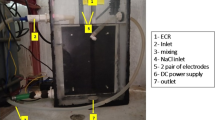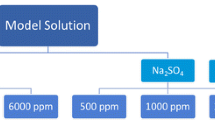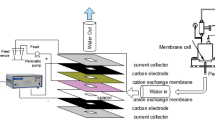Abstract
Remote and mobile refineries are designed to utilize local groundwater (if abundantly available) to meet their industrial applications and inner uses. However, groundwater usually suffers hardness and salinity. Therefore, reverse osmosis (RO) technology is applied to treat the groundwater before use. The RO concentrate water stream is mixed with other refinery wastewater effluents resulting in a high saline wastewater. Upon discharging the refinery wastewater in constructed or natural lagoons, organic and non-organic pollutants permeate to groundwater reservoirs (aquifers) causing groundwater contamination build-up. The present study adopted the response surface methodology (RSM) to evaluate and optimize the simultaneous extraction of Pb2+, Cu2+, and Cd2+ ions from a refinery saline wastewater using emulsion liquid membrane (ELM). The experimental results were compared with those obtained from a previous study conducted for a simulated synthetic wastewater. Lower removal efficiencies of Pb2+, Cu2+, and Cd2+ ions were noticed for the refinery (real) wastewater due to possible interactions between dissolved salts of salinity, and metal ions. The lower removal efficiencies are due to the potential chemical complexation of the heavy metal ions with the petroleum organic and inorganic anions during the cations/carrier complexation at the wastewater/membrane interface which hinders the free migration of the metal ions. Also higher breakage was observed to cause lower stability of the ELM system in comparison with the simulated synthetic wastewater system. The impacts of the feed pH (2–6), homogenizer speed (5700–19,700 rpm), surfactant concentration (2–6%v/v), and carrier concentration (2–6%v/v) on the removal efficiencies of the Pb2+, Cu2+, and Cd2+ ions were investigated. The results of the regression analysis showed that experimental data could be fitted to quadratic models with values of determination coefficients (R2) equal to 91.18%, 88.91%, and 91.16% for Pb2+, Cu2+, and Cd2+ respectively. Maximum removal efficiencies of 92.33%, 88.98%, and 76.29% for Pb2+, Cu2+, and Cd2+ ions respectively were obtained at the optimum operating conditions of feed pH of 5.15, homogenizer speed of 5700 rpm, surfactant concentration of 3.97% v/v, and carrier concentration of 6% v/v.





Similar content being viewed by others
References
Michiaki, M.; Abhishek, P.; Yuuki, M.; Kazuo, K.: Effect of ammonium-and phosphonium-based ionic liquids on the separation of lactic acid by supported ionic liquid membranes (SILMs). Membranes 1, 98–108 (2011)
Begum, K.M.M.S.; Venkatesan, S.; Anantharaman, N.: Emulsion liquid membrane pertraction of metal ions from aqueous solutions and electroplating effluent using rotating disk contactor. Chem. Eng. Commun. 199, 1575–1595 (2012)
Kim, S.M.; Na, J.G.; Lee, M.K.M.; Ryu, H.; Chang, Y.K.; Triolo, J.M.; Yun, Y.M.; Kim, D.H.: More value from food waste: lactic acid and biogas recovery. Water Res. 96, 208–216 (2016)
Mohammed, A.A.; Hussein, M.A.; Albdiri, A.D.Z.: Application of bulk liquid membrane technique for cadmium extraction from aqueous solution. Arab. J. Sci. Eng (2018). https://doi.org/10.1007/s13369-017-3039-4
Albdiri, A.D.Z.; Mohammed, A.A.; Hussein, M.; Koter, S.: Modeling of lead ions transport through a bulk liquid membrane. Desalin. Water Treat. 181, 213–220 (2020). https://doi.org/10.5004/dwt.2020.25098
Koter, S.; Szczepanśki, P.; Mateescu, M.; Nechifor, G.; Badalau, L.; Koter, I.: Modeling of the cadmium transport through a bulk liquid membrane. Sep. Purif. Technol. (2013). https://doi.org/10.1016/j.seppur.2013.01.032
Kumbasar, R.A.: Selective extraction of chromium(VI) from multicomponent acidic solutions by emulsion liquid membranes using tributhylphosphate as carrier. J. Hazard. Mater. 178, 875–882 (2010)
Kumar, A.; Thakur, A.; Panesar, P.S.: A review on emulsion liquid membrane (ELM) for the treatment of various industrial effluent streams . Rev. Environ. Sci. Biotechnol (2019). https://doi.org/10.1007/s11157-019-09492-2
Gega, J.; Walkowiak, W.; Gajda, B.: Separation of Co(II) and Ni(II) ions by supported and hybrid liquid membranes. Sep. Purif. Technol. 22–23, 551–558 (2001)
Wood, R.A.; Roscoe, R.V.: The isolation of manganese in a system between bis (2- ethyl-hexyl) hydrogen phosphate and aqueous nitric acid. J. Inorgan. Nucl. Chem 32, 1351–1355 (1970)
Sahoo, G.C.; Dutta, N.N.: Studies on emulsion liquid membrane extraction of cephalexin. J. Membr. Sci 145, 15–26 (1998)
Mohammed, A.A.; Selman, H.M.; Abukhanafer, G.: Liquid surfactant membrane for lead separation from aqueous solution: studies on emulsion stability and extraction efficiency. J. Environ. Chem. Eng. 6(6), 6923–6930 (2018). https://doi.org/10.1016/j.jece.2018.10.02
Zarandi, M.N.; Soltani, A.: Emulsion liquid membrane design in vitro for removal of lead from aqueous solution. Orient. J. Chem. 34(6), 2747–2754 (2018). https://doi.org/10.13005/ojc/340609
Ma, H.; Kökkılıç, O.; Waters, K.E.: The use of the emulsion liquid membrane technique to remove copper ions from aqueous systems using statistical experimental design. Miner. Eng. 107, 88–99 (2017). https://doi.org/10.1016/j.mineng.2016.10.014
Lu, D.; Chang, Y.; Wang, W.; Xie, F.; Asselin, E.; Dreisinger, D.: Copper and cyanide extraction with emulsion liquid membrane with LIX 7950 as the mobile carrier: part 1, emulsion stability. Metals (Basel) 5(4), 2034–2047 (2015). https://doi.org/10.3390/met5042034
Ahmad, A.L.; Kusumastuti, A.; Derek, C.J.C.; Ooi, B.S.: Emulsion liquid membrane for cadmium removal: studies on emulsion diameter and stability. Desalination 287, 30–34 (2012). https://doi.org/10.1016/j.desal.2011.11.002
Benderrag, A.; Haddou, B.; Daaou, M.; Benkhedja, H.; Bounaceur, B.; Kameche, M.: Experimental and modeling studies on Cd(II) ions extraction by emulsion liquid membrane using Triton X-100 as biodegradable surfactant. J. Environ. Chem. Eng. (2019). https://doi.org/10.1016/j.jece.2019.103166
Shamkhi, H.A.; Albdiri, A.D.Z.; Jabir, F.A.; Koter, S.S.: Experimental and modeling studies on simultaneous extraction of Pb2+, Cu2+, and Cd2+ from diluted acidic aqueous solutions by emulsion liquid membrane Chem. Eng. Commun (2020). https://doi.org/10.1080/00986445.2020.1855152
Jabbari, A.; Esmaeili, M.; Shamsipur, M.: Selective transport of mercury as Hg2Cl42− through a bulk liquid membrane using K+-dicyclohexyl-18-crown-6 as a carrier. Sep. Purif. Technol. 24, 139 (2001)
Umar, M.; Aziz, H.A.; Yusoff, M.S.: Assessing the chlorine disinfection of landfill leachate and optimization by response surface methodology (RSM). Desalination 274(1–3), 278–283 (2011)
Goyal, R.K.; Jayakumar, N.S.; Hashim, M.A.: A comparative study of experimental optimization and response surface optimization of Cr removal by emulsion ionic liquid membrane. J. Hazard. Mater. 195, 383–390 (2011)
Gupta, S.; Chakraborty, M.; Murthy, Z.V.P.: Response surface modeling and optimization of mercury extraction through emulsion liquid membrane. Sep. Sci. Technol. 46, 2332–2340 (2011)
Nazim, M.; Pal, P.; Al, S.A.; Elkamel, A.: Optimization of the cementation process for the removal of copper in process effluent discharges. Chem. Eng. Technol. 35(10), 1744–1755 (2012)
Parhi, P.K.; Sarangi, K.; Mohanty, S.: Process optimization and extraction of nickel by hollow fiber membrane using response surface methodology. Miner. Metall. Process. 29(4), 225–230 (2012)
Sabah, H.; Thouraya, T.; Melek, H.; Nadia, M.: Application of response surface methodology for optimization of cadmium ion removal from an aqueous solution by eggshell powder. Chem. Res. Chin. Univ. 34(2), 302–310 (2018)
Sudamalla, P.; Saravanan, P.; Matheswaran, M.: Optimization of operating parameters using response surface methodology for adsorption of crystal violet by activated carbon prepared from mango kernel. Environ. Res 22(1), 1–7 (2012)
Prabhakaran, D.; Basha, C.A.; Kannadasan, T.; Aravinthan, P.: Removal of hydroquinone from water by electrocoagulation using flow cell and optimization by response surface methodology. J. Environ. Sci. Health A 45(4), 400–412 (2010)
Khataee, A.R.; Zarei, M.; Moradkhannejhad, L.: Application of response surface methodology for optimization of azo dye removal by oxalate catalyzed photoelectro-Fenton process using carbon nanotube-PTFE cathode. Desalination 258(1–3), 112–119 (2010)
Körbahti, B.K.: Response surface optimization of electrochemical treatment of textile dye wastewater. J. Hazard. Mater. 145(1–2), 277–286 (2007)
Thirugnanasambandham, K.; Sivakumar, V.; Prakash, M.J.: Treatment of egg processing industry effluent using chitosan as an adsorbent. J. Serb. Chem. Soc. 79(6), 743–757 (2014)
Sulaymon, A.H.; Mohammed, S.A.M.; Abbar, A.H.: Cadmium removal from simulated chloride wastewater using a novel flow-by fixed bed electrochemical reactor: Taguchi approach. Desalin. Water Treat. 74, 197–206 (2017)
Mohammed, A.A.; Atiya, M.A.; Hussein, M.A.: Studies on membrane stability and extraction of ciprofloxacin from aqueous solution using pickering emulsion liquid membrane stabilized by magnetic nano-Fe2O3. Colloids Surf. A Physicochem. Eng. Asp. 585, 124044 (2020). https://doi.org/10.1016/j.colsurfa.2019.124044
Salman, H.M.; Mohammed, A.A.: Extraction of lead ions from aqueous solution by co-stabilization mechanisms of magnetic Fe2O3 particles and nonionic surfactants in emulsion liquid membrane. Colloids Surf. A Physicochem. Eng. Asp. 568, 301–310 (2019). https://doi.org/10.1016/j.colsurfa.2019.02.018
Chiha, M.; Samar, M.H.; Hamdaoui, O.: Extraction of chromium(VI) from sulphuric acid aqueous solutions by a liquid surfactant membrane (LSM). Desalination 194(1–3), 69–80 (2006). https://doi.org/10.1016/j.desal.2005.10.025
Chiha, M.; Hamdaoui, O.; Ahmedchekkat, F.; Pétrier, C.: Study on ultrasonically assisted emulsification and recovery of copper(II) from wastewater using an emulsion liquid membrane process. Ultrason. Sonochem. 17(2), 318–325 (2006). https://doi.org/10.1016/j.ultsonch.2009.09.001
Laki, S.; Kargari, A.: Extraction of silver ions from aqueous solutions by emulsion liquid membrane. J. Membr. Sci. Res. 2(1), 33–40 (2016). https://doi.org/10.22079/jmsr.2016.15876
Bezerra, M.A.; Santelli, R.E.; Oliveira, E.P.; Villar, L.S.; Escaleira, L.A.: Response surface methodology (RSM) as a tool for optimization in analytical chemistry. Talanta 76(5), 965–977 (2008). https://doi.org/10.1016/j.talanta.2008.05.019
Yetilmezsoy, K.; Demirel, S.; Vanderbei, R.J.: Response surface modeling of Pb(II) removal from aqueous solution by Pistacia vera L.: Box–Behnken experimental design. J. Hazard. Mater. 171(1–3), 551–562 (2009)
Rajasimman, M.; Sangeetha, R.; Karthik, P.: Statistical optimization of process parameters for the extraction of chromium(VI) from pharmaceutical wastewater by emulsion liquid membrane. Chem. Eng. J. 150(2), 275–279 (2009)
Jiao, H.P.; Peng, W.; Zhao, J.T.; Xu, C.J.: Extraction performance of bisphenol A from aqueous solutions by emulsion liquid membrane using response surface methodology. Desalination 313(15), 36–43 (2013)
Huiping, L.; Guoqun, Z.; Shanting, N.; Yiguo, L.: Technologic parameter optimization of gas quenching process using response surface method. Comput. Mater. Sci. 38(4), 561–570 (2007)
Jiao, H.; Peng, W.; Zhao, J.; Xu, C.: Extraction performance of bisphenol A from aqueous solutions by emulsion liquid membrane using response surface methodology. DES 313, 36–43 (2013). https://doi.org/10.1016/j.desal.2012.12.002
Raji, M.; Abolghasemi, H.; Safdari, J.; Kargari, A.: Response surface optimization of dysprosium extraction using an emulsion liquid membrane integrated with multi-walled carbon nanotubes. Chem. Eng. Technol. 41(9), 1857–1870 (2018). https://doi.org/10.1002/ceat.201700351
Moradi, M.; Alvarado, V.; Huzurbaza, S.: (2010) Effect of salinity on water-in-crude oil emulsion: evaluation through drop-size distribution proxy. Energy Fuels 25, 260–268 (2011). https://doi.org/10.1021/ef101236h
Ostad-Ali-Askari, K.; Shayannejad, M.; Ghorbanizadeh Kharazi, H.: Artificial neural network for modeling nitrate pollution of groundwater in marginal area of Zayandeh-Rood River, Isfahan, Iran. KSCE J. Civ. Eng. Korean Soc. Civ. Eng. 21(1), 134–140 (2016). https://doi.org/10.1007/s12205-016-0572-8
Asadian, H.; Ahmadi, A.: The extraction of gallium from chloride solutions by emulsion liquid membrane: optimization through response surface methodology . Miner. Eng (2020). https://doi.org/10.1016/j.mineng.2020.106207
Acknowledgements
The financial support of the DOS through the IREX organization to conduct a groundwater remediation project at Ash Shinafiyah desert, Iraq, is highly appreciated. The appreciation is also extended to the administrative and technical staff of the Ad Diwaniyah refinery, Al-Qadisiyah province, Iraq, for their assistance in carrying out some of the tests at the central laboratory of the refinery.
Author information
Authors and Affiliations
Corresponding author
Rights and permissions
About this article
Cite this article
Shamkhi, H.A., Albdiri, A.D.Z., Jabir, F.A. et al. Removal of Pb2+, Cu2+, and Cd2+ Ions from a Saline Wastewater Using Emulsion Liquid Membrane: Applying Response Surface Methodology for Optimization and Data Analysis. Arab J Sci Eng 47, 5705–5719 (2022). https://doi.org/10.1007/s13369-021-05624-5
Received:
Accepted:
Published:
Issue Date:
DOI: https://doi.org/10.1007/s13369-021-05624-5




